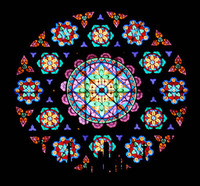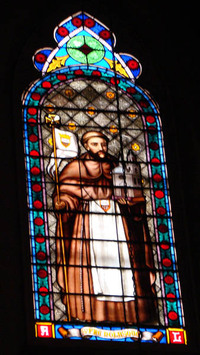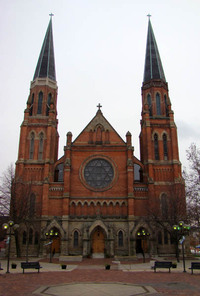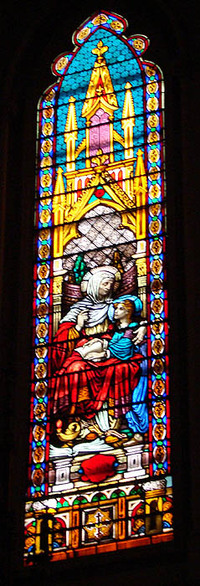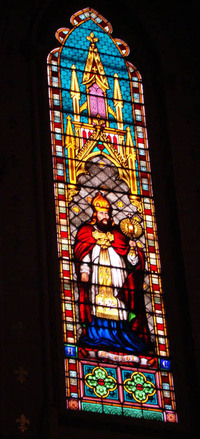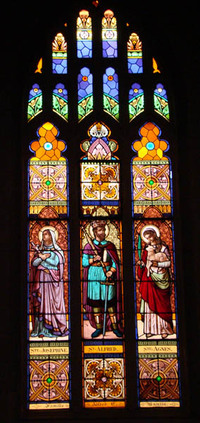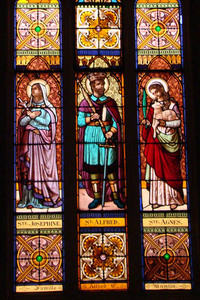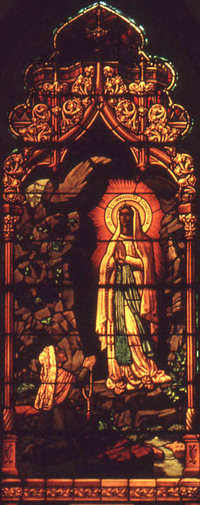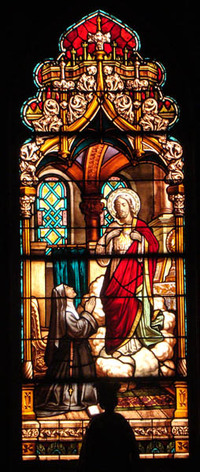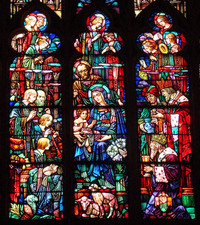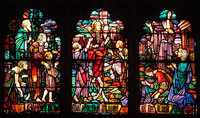MSGC : Featured Windows : Current Window
Featured Windows, July-August 2008
Ste. Anne de Detroit Catholic Church Detroit, MI
Building: Ste. Anne de Detroit Catholic Church
City: Detroit
State: Michigan
Ste. Anne de Detroit Catholic Church, Detroit, MI. 1886-1887. French and Coquard. Ste. Anne de Detroit Catholic Church, the oldest Catholic parish in Michigan and second oldest parish in the country, traces its beginning to July 26, 1701, two days after the French explorer Antoine de la Mothe Cadillac and his party landed at the site of present-day Detroit, where they established Fort Pontchartrain. The first church, a small log chapel erected by Cadillac and his men on the Feast Day of Ste. Anne, was destroyed by fire in 1703. Over the next two centuries, several successive church homes were constructed and then lost to war or fire. The seventh church, built of stone, was erected between 1818 and 1828 during the pastorate of Father Gabriel Richard (1767-1832), who served the church from 1802 until his death from cholera in 1832. A man of many achievements, Father Richard is remembered for printing Michigan's first newspaper in 1809, co-founding the University of Michigan in 1817, and his election to Congress in 1823. The eighth and present church home was completed in 1887. Designed by architect Albert E. French and parishioner Leon Coquard in the Gothic Revival style, the cruciform brick and limestone building features twin spire-topped towers, flying buttresses, and a chapel containing the tomb of Father Richard. Its soaring interior is filled with colored light coming from two levels of stained glass windows that were made at different times by three different studios. Many of the windows depict French saints revered by the founders and early parishioners of the church. The earliest windows, perhaps the oldest stained glass in the city, were brought from the 1818 church along with other artifacts that included a communion rail carved by Detroit sculptor Julius Melchers. These upper-level grisaille and figural windows are attributed to the Detroit studio of
Friederichs and Staffin, later renamed the Detroit Stained Glass Works. The studio was founded in 1860, so its earliest windows at the present church were made between that year and the mid-1880s, when the stone church of 1818 was torn down.
Left: St. Fre Nolasque. Friederichs and Staffin, Detroit, MI, ca. 1860-1880. One of the windows that came from the 1818 church depicts French-born Pierre Nolasque, or Peter Nolasco, (1189-1256), who fought against the Moors in the Iberian Peninsula and founded the Order of Mercy to tend the sick and ransom Christians captured by the Moors.
Right: Rose Window. Friederichs and Staffin, Detroit, MI, 1886. In 1886 Friederichs and Staffin provided more windows for the new church, including a rose window for the west façade, five windows high above the main altar and two large transept windows. The central window above the altar depicts Ste. Anne with the young Virgin Mary; two windows on either side hold the figures of four French saints: St. Eloi, St. Remi, St. Martin and St. Denis.
Left: Ste. Anne with the young Virgin Mary. Friederichs and Staffin, Detroit, MI, 1886. Ste. Anne is teaching her young daughter, the Virgin Mary.
Right: St. Eloi. Friederichs and Staffin, Detroit, MI, 1886. St. Eloi (588-660) was a skillful goldsmith at Limoges, known for his piety, honesty and charity. Ordained in 640, he became Bishop of Noyon and counselor to the French king, ransomed slaves, and built churches, monasteries and a convent. He is revered as the patron saint of metal workers, especially blacksmiths who work with horses. Most of the lower-level windows hold three figures each, to represent the patron saints of the various window donors. The result is an unusual assemblage of biblical and historical saints. Several names of prominent early Detroit families can be found on these windows, which are attributed to the Bavarian Stained Glass Company of Minneapolis, MN, a studio about which little is known.
St. Josephine, St. Alfred, and St. Agnes. Bavarian Stained Glass Company of Minneapolis, MN, 1886. This window depicts three patron saints of its donors, the Hamlin family. The figures represent Blessed Josephine Leroux, an Ursuline nun at Valenciennes, guillotined in 1794 for her faith during the French Revolution; St. Alfred the Great, ninth-century English king and scholar, who translated religious writings into English; and St. Agnes of Rome, third-century Christian maiden, martyred for her consecrated vow to virginity.
St. Bernadette
(left) and The Sacred Heart of Jesus
(right). Buffalo Stained Glass Works, Buffalo, NY, 1886. Two other windows on the lower level of the sanctuary were made by the Buffalo Stained Glass Works of Buffalo, NY. They illustrate the religious visions reported by two young French women: Our Lady of Lourdes, a vision of the Virgin Mary that appeared to young Bernadette Soubirous at Lourdes, France, in 1858: and the Sacred Heart of Jesus, a vision seen by a seventeenth-century French nun, Margaret Mary Alocoque. The Buffalo Stained Glass Works, operated by Ferdinand J. Riester and Godfrey Frohe, created windows for many churches in the late nineteenth century. Two large transept windows are the latest stained glass in Ste. Anne Church, installed in 1919 to replace the original transept windows that had been destroyed by a tornado. Each window depicts two biblical scenes, one above the other: in the south transept, The Coming of the Magi above a scene depicting Jesus' Entry into Jerusalem; and in the north transept, The Sermon on the Mount over a scene of The Last Supper. The transept windows of 1919 were provided by the Detroit Stained Glass Works, originally known as Friederichs and Staffin.
The Coming of the Magi
(left) and Jesus' Entry into Jerusalem
(right). The Detroit Stained Glass Works (originally Friederichs and Staffin), 1919. In the three centuries since the founding of Ste. Anne Catholic Church, its French parishioners have been replaced by worshippers with close ties to other cultures: Irish immigrants as early as the 1820s, followed by Hispanic people in the 1940s. During the late twentieth century, economic recessions and urban decay within the city forced many parishioners to move to suburbs. Faced with loss of parishioners, lack of money, growing disrepair and threatened with closure, Ste. Anne Church struggled to survive. But its remaining parishioners secured funding from foundation and government sources for a major renovation of the church and many new programs were begun to meet their spiritual and social needs. Today the church serves a predominantly Hispanic congregation, with some of its worship services conducted in Spanish. Ste. Anne de Detroit Catholic Church was photographed and registered in the Michigan Stained Glass Census by David and Marion Spitzley of Grosse Pointe, MI.
Bibliography:
Show BibliographyAshlee, Laura Rose, ed. Traveling Through Time: A Guide to Michigan's Historical Markers, Rev. ed. Ann Arbor: The University of Michigan Press, 2005. Dempsey, Mary A. "Ste. Anne de Detroit." Lansing, MI: Michigan History Magazine, November/December, 2000. Eckert, Kathryn Bishop, ed. Buildings of Michigan. New York: Oxford University Press, 1993. Ferry, W. Hawkins. The Buildings of Detroit: A History. Detroit, MI: Wayne State University Press, 1968. Godzak, Roman. Make Straight the Path: A 300-Year Pilgrimage: Archdiocese of Detroit. Strasbourg, France: E_ditions du Signe, 2000. The Holy Bible, King James Version. (New York: American Bible Society, 1999). Published May 2000 by Bartleby.com; © Copyright Bartleby.com, Inc. Jones, Robert O. Biographical Index of Historic American Stained Glass Workers. Kansas City, MO: Stained Glass Association of America, 2002. Metford, J.C.J. Dictionary of Christian Lore and Legend. London: Thames and Hudson, Ltd., 1983. Reilly, CSB, Rev. Leo. Ste. Anne de Detroit: A Guide Book with a Brief History. Detroit, MI: Ste. Anne de Detroit Church, 2001. Ste. Anne de Detroit Roman Catholic Church (Detroit, MI), E. Phillips Mantz, and Michael J. Roach. The Story of Ste. Anne De Detroit Church, Detroit, Michigan, 1701-1976, and the Bicentennial History of Catholic America. Hackensack, NJ: Custombook, 1976. "Stained Glass Windows (and Statues) of Ste. Anne's, Detroit with Donors" (One page tour guide). Detroit, MI: Ste. Anne de Detroit Church, n.d. Michigan Stained Glass Census file 94.0058, Michigan State University Museum, East Lansing, MI. "Ste. Anne de Detroit, Established 1701" (Pamphlet). Detroit, MI: Ste. Anne de Detroit Church, n.d. Michigan Stained Glass Census file 94.0058, Michigan State University Museum, East Lansing, MI. Ste. Anne de Detroit Catholic Church. "Ste. Anne de Detroit History" (2008). http://www.ste-anne.org/history.htm. Tutag, Nola Huse. Discovering Stained Glass in Detroit. Detroit, MI: Wayne State University Press, 1987. (MSGC 1994.0058)
Text by Betty MacDowell, Michigan Stained Glass Census, July , 2008.

